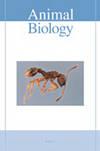青藏高原东部7个雄性褐蛙种群生殖投资的地理变异
IF 0.9
4区 生物学
Q2 ZOOLOGY
引用次数: 0
摘要
生活史理论表明,生活在恶劣和不可预测的环境条件下(例如,低温和/或高季节性)的雄性无尾猿应该减少生殖投资,因为活动周期短,生产力低。尽管在广泛的分类群中对女性生活史特征的地理差异进行了深入的研究,但对男性的类似研究却很少。本文研究了青藏高原东部7个不同海拔地区褐蛙(Rana kukuunoris)雄性睾丸质量的地理差异,并验证了睾丸质量的相对大小应该随着温度的升高和/或季节的减少而增加的假设。在本研究中,我们发现男性的身体状况、年龄和睾丸质量不随温度和温度季节性而增加,这与我们之前的假设不一致,这表明不同种群的温度和温度季节性差异不能驱动睾丸大小的进化。然而,我们发现在控制种群和温度的影响以及温度季节性的情况下,睾丸质量与身体状况或年龄呈正相关,表明睾丸大小的表达依赖于条件。此外,睾丸质量和实际性别比之间的相关性并不显著,这表明雄性之间的竞争不会导致精子竞争水平的增加。本文章由计算机程序翻译,如有差异,请以英文原文为准。
Geographic variation in reproductive investment of seven populations of male Brown frog (Rana kukunoris), endemic to the eastern Tibetan Plateau
Life-history theory suggests that male anurans living in harsh and unpredictable environmental conditions (e.g., low temperature and/or high seasonality) should decrease reproductive investment because of short periods of activity and poor productivity. Although geographic variations in female life-history traits have been investigated intensively across a wide range of taxa, similar studies in males have been scarce. Here, we examined geographic variation in male testis mass of the brown frog (Rana kukunoris) across seven different altitudes on the eastern Tibetan plateau, and tested the hypothesis that relative size of testis mass should increase with increasing temperature and/or decreasing seasonality. In this study, we found male body condition, age and testis mass did not increase with temperature and temperature seasonality, which do not conform to our previous hypothesis, revealing that differences in temperature and temperature seasonality across populations could not drive the evolution of testis size. However, we found a positive correlation between testis mass and body condition or age when controlling for population and the effect of temperature and temperature seasonality, indicative of a condition-dependent expression of testis size. In addition, a correlation between testis mass and operational sex ratio was not significant, suggesting that male–male competition did not lead to increasing levels of sperm competition.
求助全文
通过发布文献求助,成功后即可免费获取论文全文。
去求助
来源期刊

Animal Biology
生物-动物学
CiteScore
2.10
自引率
0.00%
发文量
34
审稿时长
3 months
期刊介绍:
Animal Biology publishes high quality papers and focuses on integration of the various disciplines within the broad field of zoology. These disciplines include behaviour, developmental biology, ecology, endocrinology, evolutionary biology, genomics, morphology, neurobiology, physiology, systematics and theoretical biology. Purely descriptive papers will not be considered for publication.
Animal Biology is the official journal of the Royal Dutch Zoological Society since its foundation in 1872. The journal was initially called Archives Néerlandaises de Zoologie, which was changed in 1952 to Netherlands Journal of Zoology, the current name was established in 2003.
 求助内容:
求助内容: 应助结果提醒方式:
应助结果提醒方式:


